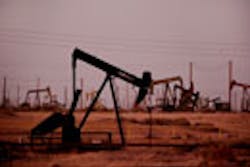Oil prices have started--albeit it slowly—to drop this week, falling from a record high of $145 per barrel on July 3 to closing at $135.64 a barrel yesterday. But will this lead to any savings at the pump?
Diesel prices did not react this week to the falling price of crude oil, increasing 8 cents per gallon for the week of July 7 to a new record high of $4.72 per gallon, according to information from the Energy Information Administration (EIA).
“Diesel fuel retail prices in 2008 are projected to average $4.35 per gallon, up from $2.88 per gallon last year, and increase to an average of $4.48 per gallon in 2009,” EIA stated in its monthly Short-Term Energy Outlook. “These higher prices reflect strength in diesel demand, particularly in emerging markets, which has significantly increased the margins between diesel prices and crude oil costs from those of last year. Over the next few months, these prices are projected to remain near the June 30 price of $4.65 per gallon as refiner margins begin to weaken slightly, offsetting the projected rise in crude oil costs.”
According to EIA, West Texas Intermediate (WTI) crude oil prices continue to be pressured by global supply uncertainties and demand growth in China, the Middle East and Latin America, with prices projected to average $127 per barrel in 2008 and $133 per barrel in 2009. Retail diesel fuel prices are projected to average $4.35 in 2008 and $4.45 per gallon in 2009, EIA added.
Even though oil consumption in the United States is starting to slow--according to the Wall Street Journal, U.S. drivers are traveling at the lowest rate in five years, and gasoline consumption on the Fourth of July weekend fell 3.3% from last year-- worldwide oil consumption continues to grow, with EIA estimating an extra 900,000 barrels per day (bbl/d) consumed in 2008 and 1.4 million bbl/d in 2009, even with U.S. consumption expected to decline by about 400,000 bbl/d in 2008. At the current time, there simply isn’t enough supply to easily satisfy demand, even with Saudi
Arabia planning to raise production from 9.4 million bbl/d in June to 9.7 bbl/d in July.
“The oil market remains tight, evidenced by rising prices, low surplus production capacity, and the concern that global supply growth may not keep pace with demand growth over the near term,” EIA said. “Preliminary estimates indicate that higher oil consumption in the second quarter and a modest increase in production left Organization for Economic Cooperation and Development (OECD) commercial inventories below the 5-year average at the end of June.”
According to EIA, non-OPEC supply is supposed to rise by 230,000 bbl/d in 2008 and 830,000 bbl/d in 2009, far lower than projections at the beginning of the year of an increase of 860,000 bbl/d in 2008 and over 1.5 million bbl/d in 2009. OPEC supply, on the other hand, stayed relatively steady, averaging 32.3 million bbl/d in the second quarter, up from 32.2 in the first quarter, with EIA projecting 32.7 bbl/d for the third quarter of 2008.
U.S. production is projected to average 5.14 million bbl/d, slightly higher than the 2007 average of 5.10 million bbl/d, EIA said, projecting an average of 5.27 bbl/d in 2009.
